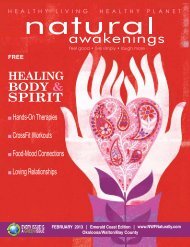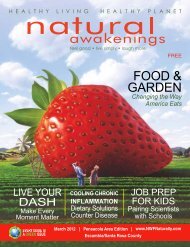VIBRANT WELL-BEING
VIBRANT WELL-BEING - Nwfnaturally.com
VIBRANT WELL-BEING - Nwfnaturally.com
- No tags were found...
You also want an ePaper? Increase the reach of your titles
YUMPU automatically turns print PDFs into web optimized ePapers that Google loves.
Tangerines’ Tangible Gifts<br />
Tangerines are sweet, affordable and in season, and now there’s another reason<br />
to stock up on this juicy fruit. Researchers from the University of Western Ontario<br />
have discovered that a tangerine flavonoid, nobiletin, appears to help prevent<br />
obesity and protect against Type 2 diabetes and atherosclerosis, the leading cause<br />
of heart attacks and strokes.<br />
When the researchers fed mice a “Western” diet high in fats and simple sugars,<br />
they became obese, showing all the signs associated with metabolic syndrome:<br />
elevated cholesterol and triglycerides, high blood levels of insulin and glucose, and<br />
fatty livers. A second group of mice—fed the same unhealthy<br />
diet, but with nobiletin added—experienced no<br />
symptoms of metabolic syndrome and<br />
gained weight normally. Ingesting nobiletin<br />
also prevented the buildup of fat in the<br />
liver by stimulating genes that help burn<br />
excess body fat, while inhibiting genes<br />
responsible for manufacturing it.<br />
The Heavy Secret<br />
of Fake Fats<br />
Food containing synthetic fats—which taste like natural<br />
fats, but with fewer calories—may sound enticing to<br />
dieters. However, fat substitutes used in low-calorie potato<br />
chips and other processed foods could instead backfire and<br />
contribute to weight gain and obesity. Findings by Purdue<br />
University scientists published online in the American<br />
Psychological Association’s journal, Behavioral Neuroscience,<br />
challenges marketing claims that foods made with fat<br />
substitutes help with weight loss. Apparently, the hitch is<br />
that synthetic fats can interfere with the body’s ability to regulate food intake, leading<br />
to inefficient use of calories and weight gain.<br />
The Power of Good Posture<br />
Mother’s warnings against slouching were correct. Recent research<br />
proves that poor posture not only makes a bad impression,<br />
it can make us feel physically weaker. The study, published in<br />
the Journal of Experimental Social Psychology, explored the relationship<br />
of posture and pain tolerance and found that by simply<br />
adopting more dominant poses, individuals can feel more powerful,<br />
in control and better able to tolerate distress. More, those<br />
studied using the most dominant posture were able to comfortably<br />
tolerate more pain than others assigned a more neutral or<br />
submissive stance.<br />
People tend to curl up into a ball when in pain, but the University<br />
of Southern California researchers recommend doing the<br />
opposite—try sitting or standing up straight, lifting the chin, pushing<br />
out the chest and generally expanding the body shape. They<br />
suggest that these small, yet empowering, changes in behavior can<br />
decrease sensitivity to pain. Adopting a powerful posture may even<br />
affect the body’s hormone levels, boosting testosterone, which is<br />
associated with increased pain tolerance, and decreasing cortisol,<br />
typically released in response to stress.<br />
Probiotics<br />
Help<br />
Prevent<br />
Eczema<br />
study by researchers at<br />
A the Norwegian University<br />
of Science and Technology<br />
shows that the incidence of<br />
eczema in children of mothers<br />
that drank milk fortified with<br />
a probiotic supplement during<br />
pregnancy and while breastfeeding<br />
was about half that<br />
experienced otherwise.<br />
Source: British Journal of Dermatology<br />
Sharalee Hoelscher, RCST ®<br />
Registered Craniosacral Therapist<br />
Certified Rolfer<br />
Rolfing®<br />
&<br />
Biodynamic<br />
Craniosacral<br />
Therapy<br />
Lic. # MA34039 850-450-8508<br />
www.HealingWithBodywork.com<br />
globalbriefs<br />
Going Out Green<br />
New Mortuary Practices Reduce<br />
Mercury Pollution<br />
Resomation, Ltd., in Glasgow, Scotland,<br />
has invented a new alkaline hydrolysis unit as a<br />
green alternative to cremation. Founder Sandy Sullivan<br />
plans to install the first one in America at the Anderson-Mc-<br />
Queen Funeral Home, in St. Petersburg, Florida.<br />
Mercury from dental fillings vaporized in crematoria has been blamed for up<br />
to 16 percent of British airborne mercury emissions, and many facilities there are<br />
fitting costly mercury filtration systems to meet reduced emission targets.<br />
The device dissolves the body in heated, pressurized, alkaline water. Makers<br />
claim the process produces one-third less greenhouse gas than cremation, uses<br />
one-seventh of the energy and allows for complete separation of mercury-laden<br />
dental amalgam for safe disposal.<br />
Sullivan, a biochemist, says tests have proven the effluent is sterile, contains<br />
no DNA and poses no environmental risk. He believes it can rival cremation for<br />
cost. The technology has been legalized in seven states to date.<br />
Another green alternative, Promession, is under development by Swedish<br />
Biologist Susanne Wiigh-Masak. It involves a fully automated machine that removes<br />
the body from the coffin and freezes it with liquid nitrogen. Vibrating breaks<br />
the corpse into fragments, which are then dried, refined and filtered to remove<br />
dental amalgam and other metals. The remains are then automatically poured into<br />
a biodegradable container for shallow burial.<br />
Wiigh-Masak likens the process to composting, in which organic materials<br />
convert to soil within weeks. She says that 60 countries around the world have<br />
expressed interest in the technology.<br />
Source: BBC News<br />
Future Fuels<br />
U.S. Renewable Energy Surpasses Nuclear<br />
Beginning in 2011, renewable energy production<br />
in the United States surpassed nuclear production<br />
in overall quantity and percentage. As a percentage<br />
of total U.S. energy generation, renewables<br />
are steadily, if modestly, gaining. California’s leadership<br />
goal targets the utilization of 33 percent<br />
renewable energy sources by 2020.<br />
Hydroelectric, geothermal, solar/photovoltaic,<br />
wind and biomass combined make up a growing<br />
segment of the mix: 11.7 percent as of June 2011,<br />
surpassing nuclear at 11.1 percent. For the same period in 2010, nuclear was<br />
11.6 percent, and renewable was 10.6, according to the U.S. Energy Information<br />
Administration.<br />
Forbes reports that many environmentalists, however, think that the two<br />
prominent technologies that currently make up much of the renewables sector—hydroelectric<br />
power, at 35 percent, and biomass, at 48 percent—are the least attractive.<br />
(Wind is the third-largest, at 13 percent of renewable, 1.5 percent of the total.)<br />
Large-scale hydroelectric power production has harmful impacts on river ecosystems<br />
and has become less popular in the developed world. As for biomass, each of the<br />
many types of feedstock must be evaluated individually for its emissions profile,<br />
water footprint and other considerations, such as whether farm fields or forests need<br />
that material to decompose in place in order to retain soil or ecosystem function.<br />
actionalert<br />
Faux Food<br />
Demand Labels on Genetically<br />
Engineered Foods<br />
The United<br />
States is a<br />
rarity among<br />
developed<br />
countries in<br />
that it does not<br />
require labeling<br />
of genetically<br />
engineered (GE)<br />
foods. Russia,<br />
Japan, China,<br />
Australia, New Zealand and 15 nations<br />
in the European Union require notice of<br />
GE content. A poll by ABC News shows<br />
that 93 percent of Americans want the<br />
federal government to require mandatory<br />
labeling of these foods.<br />
The nonprofit Center for Food<br />
Safety (CFS) has filed a petition with<br />
the U.S. Food and Drug Administration<br />
(FDA) demanding that the agency<br />
require the labeling of GE foods, on<br />
behalf of the Just Label It campaign<br />
(JustLabelIt.org), a coalition of 350<br />
companies, organizations, scientists,<br />
doctors and individuals dedicated to<br />
food safety and consumer rights.<br />
In 1992, the FDA issued a policy<br />
statement that GE foods were not “materially”<br />
different than traditional foods,<br />
and so did not need to be labeled.<br />
Agency policy severely constricts differences<br />
only to alterations that can be<br />
tasted, smelled or otherwise detected<br />
through the five senses.<br />
CFS Executive Director Andrew<br />
Kimbrell states, “Current FDA policy<br />
uses 19th-century rationale for a 21stcentury<br />
issue, leaving consumers in<br />
the dark as to hidden changes to their<br />
food. It is long overdue that the FDA<br />
acknowledges the myriad reasons<br />
genetically engineered foods should<br />
be labeled and label these novel foods<br />
once and for all.” Critics claim that GE<br />
foods are linked to both personal health<br />
and environmental risks.<br />
Tell the FDA to label GE foods and<br />
more at CenterForFoodSafety.org and<br />
TrueFoodNow.org.<br />
10 Natural Awakenings of Northwest Florida www.NWFNaturally.com natural awakenings January 2012 11








